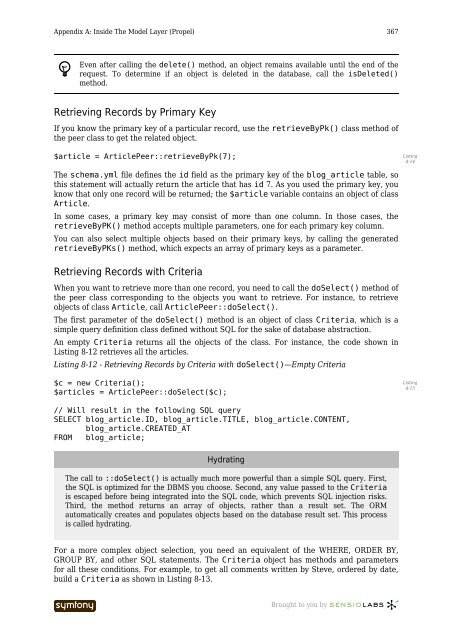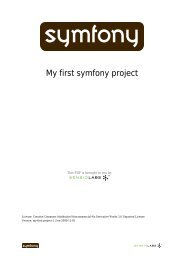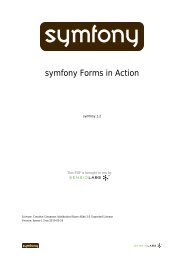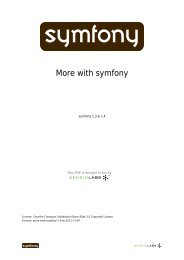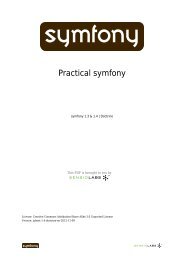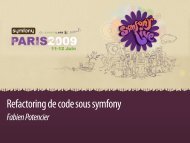- Page 3 and 4:
Table of ContentsiiiDirectory Struc
- Page 5 and 6:
Table of ContentsvRelationships ...
- Page 7 and 8:
Table of ContentsviiDetermining the
- Page 9 and 10:
Table of ContentsixTweaking the Mod
- Page 11 and 12:
Chapter 1: Introducing Symfony 11Ch
- Page 13 and 14:
Chapter 1: Introducing Symfony 13ma
- Page 15 and 16:
Chapter 1: Introducing Symfony 15Ma
- Page 17 and 18:
Chapter 1: Introducing Symfony 17po
- Page 19 and 20:
Chapter 2: Exploring Symfony’s Co
- Page 21 and 22:
Chapter 2: Exploring Symfony’s Co
- Page 23 and 24:
Chapter 2: Exploring Symfony’s Co
- Page 25 and 26:
Chapter 2: Exploring Symfony’s Co
- Page 27 and 28:
Chapter 2: Exploring Symfony’s Co
- Page 29 and 30:
Chapter 2: Exploring Symfony’s Co
- Page 31 and 32:
Chapter 2: Exploring Symfony’s Co
- Page 33 and 34:
Chapter 2: Exploring Symfony’s Co
- Page 35 and 36:
Chapter 2: Exploring Symfony’s Co
- Page 37 and 38:
Chapter 3: Running Symfony 37Chapte
- Page 39 and 40:
Chapter 3: Running Symfony 39c:\> m
- Page 41 and 42:
Chapter 3: Running Symfony 41If you
- Page 43 and 44:
Chapter 3: Running Symfony 43$ symf
- Page 45 and 46:
Chapter 3: Running Symfony 45http:/
- Page 47 and 48:
Chapter 3: Running Symfony 47Having
- Page 49 and 50:
Chapter 4: The Basics Of Page Creat
- Page 51 and 52:
Chapter 4: The Basics Of Page Creat
- Page 53 and 54:
Chapter 4: The Basics Of Page Creat
- Page 55 and 56:
Chapter 4: The Basics Of Page Creat
- Page 58 and 59:
Chapter 5: Configuring Symfony 58Li
- Page 60 and 61:
Chapter 5: Configuring Symfony 60An
- Page 62 and 63:
Chapter 5: Configuring Symfony 62Li
- Page 64 and 65:
Chapter 5: Configuring Symfony 64As
- Page 66 and 67:
Chapter 5: Configuring Symfony 66En
- Page 68 and 69:
Chapter 5: Configuring Symfony 683.
- Page 70 and 71:
Chapter 5: Configuring Symfony 70=>
- Page 72 and 73:
Chapter 5: Configuring Symfony 72Li
- Page 74 and 75:
Chapter 6: Inside The Controller La
- Page 76 and 77:
Chapter 6: Inside The Controller La
- Page 78 and 79:
Chapter 6: Inside The Controller La
- Page 80 and 81:
Chapter 6: Inside The Controller La
- Page 82 and 83:
Chapter 6: Inside The Controller La
- Page 84 and 85:
Chapter 6: Inside The Controller La
- Page 86 and 87:
Chapter 6: Inside The Controller La
- Page 88 and 89:
Chapter 6: Inside The Controller La
- Page 90 and 91:
Chapter 6: Inside The Controller La
- Page 92 and 93:
Chapter 6: Inside The Controller La
- Page 94 and 95:
Chapter 6: Inside The Controller La
- Page 96 and 97:
Chapter 6: Inside The Controller La
- Page 98 and 99:
Chapter 7: Inside The View Layer 98
- Page 100 and 101:
Chapter 7: Inside The View Layer 10
- Page 102 and 103:
Chapter 7: Inside The View Layer 10
- Page 104 and 105:
Chapter 7: Inside The View Layer 10
- Page 106 and 107:
Chapter 7: Inside The View Layer 10
- Page 108 and 109:
Chapter 7: Inside The View Layer 10
- Page 110 and 111:
Chapter 7: Inside The View Layer 11
- Page 112 and 113:
Chapter 7: Inside The View Layer 11
- Page 114 and 115:
Chapter 7: Inside The View Layer 11
- Page 116 and 117:
Chapter 7: Inside The View Layer 11
- Page 118 and 119:
Chapter 7: Inside The View Layer 11
- Page 120 and 121:
Chapter 7: Inside The View Layer 12
- Page 122 and 123:
Chapter 8: Inside The Model Layer (
- Page 124 and 125:
Chapter 8: Inside The Model Layer (
- Page 126 and 127:
Chapter 8: Inside The Model Layer (
- Page 128 and 129:
Chapter 8: Inside The Model Layer (
- Page 130 and 131:
Chapter 8: Inside The Model Layer (
- Page 132 and 133:
Chapter 8: Inside The Model Layer (
- Page 134 and 135:
Chapter 8: Inside The Model Layer (
- Page 136 and 137:
Chapter 8: Inside The Model Layer (
- Page 138 and 139:
Chapter 8: Inside The Model Layer (
- Page 140 and 141:
Chapter 8: Inside The Model Layer (
- Page 142 and 143:
Chapter 9: Links And The Routing Sy
- Page 144 and 145:
Chapter 9: Links And The Routing Sy
- Page 146 and 147:
Chapter 9: Links And The Routing Sy
- Page 148 and 149:
Chapter 9: Links And The Routing Sy
- Page 150 and 151:
Chapter 9: Links And The Routing Sy
- Page 152 and 153:
Chapter 9: Links And The Routing Sy
- Page 154 and 155:
Chapter 9: Links And The Routing Sy
- Page 156 and 157:
Chapter 9: Links And The Routing Sy
- Page 158 and 159:
Chapter 9: Links And The Routing Sy
- Page 160 and 161:
Chapter 10: Forms 160Listing10-2'em
- Page 162 and 163:
Chapter 10: Forms 162Listing10-6"";
- Page 164 and 165:
Chapter 10: Forms 164Listing10-10St
- Page 166 and 167:
Chapter 10: Forms 166value="0">Prog
- Page 168 and 169:
Chapter 10: Forms 168Listing10-17//
- Page 170 and 171:
Chapter 10: Forms 170Third-party pl
- Page 172 and 173:
Chapter 10: Forms 172To put the req
- Page 174 and 175:
Chapter 10: Forms 174...// ...resul
- Page 176 and 177:
Chapter 10: Forms 176Listing10-32Th
- Page 178 and 179:
Chapter 10: Forms 178Listing10-36Li
- Page 180 and 181:
Chapter 10: Forms 180Listing10-43Li
- Page 182 and 183:
Chapter 10: Forms 182}$this->addOpt
- Page 184 and 185:
Chapter 10: Forms 184Listing10-49Li
- Page 186 and 187:
Chapter 10: Forms 186The form submi
- Page 188 and 189:
Chapter 11: Emails 188Listing11-3$t
- Page 190 and 191:
Chapter 11: Emails 190The Delivery
- Page 192 and 193:
Chapter 11: Emails 192Note that the
- Page 194 and 195:
Chapter 11: Emails 194Each time an
- Page 196 and 197:
Chapter 11: Emails 196Sending a mes
- Page 198 and 199:
Chapter 11: Emails 198100, Swift_Pl
- Page 200 and 201:
Chapter 11: Emails 200Listing11-36C
- Page 202 and 203:
Chapter 12: Caching 202Listing12-1d
- Page 204 and 205:
Chapter 12: Caching 204For instance
- Page 206 and 207:
Chapter 12: Caching 206The code not
- Page 208 and 209:
Chapter 12: Caching 208Alternative
- Page 210 and 211:
Chapter 12: Caching 210Listing12-20
- Page 212 and 213:
Chapter 12: Caching 212Listing12-24
- Page 214 and 215:
Chapter 12: Caching 214Building a S
- Page 216 and 217:
Chapter 12: Caching 216Listing12-36
- Page 218 and 219:
Chapter 12: Caching 218If changing
- Page 220 and 221:
Chapter 13: I18n And L10n 220all:.s
- Page 222 and 223:
Chapter 13: I18n And L10n 222Standa
- Page 224 and 225:
Chapter 13: I18n And L10n 224Creati
- Page 226 and 227:
Chapter 13: I18n And L10n 226Listin
- Page 228 and 229:
Chapter 13: I18n And L10n 228Anothe
- Page 230 and 231:
Chapter 13: I18n And L10n 230[0]Nob
- Page 232 and 233:
Chapter 14: Admin Generator 232blog
- Page 234 and 235:
Chapter 14: Admin Generator 234List
- Page 236 and 237:
Chapter 14: Admin Generator 236_fil
- Page 238 and 239:
Chapter 14: Admin Generator 238In t
- Page 240 and 241:
Chapter 14: Admin Generator 240NONE
- Page 242 and 243:
Chapter 14: Admin Generator 242List
- Page 244 and 245:
Chapter 14: Admin Generator 244As t
- Page 246 and 247:
Chapter 14: Admin Generator 246Chan
- Page 248 and 249:
Chapter 14: Admin Generator 248The
- Page 250 and 251:
Chapter 14: Admin Generator 250You
- Page 252 and 253:
Chapter 14: Admin Generator 252Addi
- Page 254 and 255:
Chapter 14: Admin Generator 254_del
- Page 256 and 257:
Chapter 14: Admin Generator 256List
- Page 258 and 259:
Chapter 14: Admin Generator 258List
- Page 260 and 261:
Chapter 15: Unit And Functional Tes
- Page 262 and 263:
Chapter 15: Unit And Functional Tes
- Page 264 and 265:
Chapter 15: Unit And Functional Tes
- Page 266 and 267:
Chapter 15: Unit And Functional Tes
- Page 268 and 269:
Chapter 15: Unit And Functional Tes
- Page 270 and 271:
Chapter 15: Unit And Functional Tes
- Page 272 and 273:
Chapter 15: Unit And Functional Tes
- Page 274 and 275:
Chapter 15: Unit And Functional Tes
- Page 276 and 277:
Chapter 15: Unit And Functional Tes
- Page 278 and 279:
Chapter 15: Unit And Functional Tes
- Page 280 and 281:
Chapter 15: Unit And Functional Tes
- Page 282 and 283:
Chapter 15: Unit And Functional Tes
- Page 284 and 285:
Chapter 16: Application Management
- Page 286 and 287:
Chapter 16: Application Management
- Page 288 and 289:
Chapter 16: Application Management
- Page 290 and 291:
Chapter 16: Application Management
- Page 292 and 293:
Chapter 16: Application Management
- Page 294 and 295:
Chapter 16: Application Management
- Page 296 and 297:
Chapter 16: Application Management
- Page 298 and 299:
Chapter 16: Application Management
- Page 300 and 301:
Chapter 16: Application Management
- Page 302 and 303:
Chapter 16: Application Management
- Page 304 and 305:
Chapter 17: Extending Symfony 304Ch
- Page 306 and 307:
Chapter 17: Extending Symfony 306'r
- Page 308 and 309:
Chapter 17: Extending Symfony 308In
- Page 310 and 311:
Chapter 17: Extending Symfony 310Li
- Page 312 and 313:
Chapter 17: Extending Symfony 312Li
- Page 314 and 315:
Chapter 17: Extending Symfony 314Li
- Page 316 and 317: Chapter 17: Extending Symfony 316Li
- Page 318 and 319: Chapter 17: Extending Symfony 318
- Page 320 and 321: Chapter 17: Extending Symfony 320}/
- Page 322 and 323: Chapter 17: Extending Symfony 322pr
- Page 324 and 325: Chapter 17: Extending Symfony 324-5
- Page 326 and 327: Chapter 17: Extending Symfony 326Li
- Page 328 and 329: Chapter 18: Performance 328Chapter
- Page 330 and 331: Chapter 18: Performance 330autoload
- Page 332 and 333: Chapter 18: Performance 332Listing1
- Page 334 and 335: Chapter 18: Performance 334Listing1
- Page 336 and 337: Chapter 18: Performance 336be used
- Page 338 and 339: Chapter 18: Performance 338Listing1
- Page 340 and 341: Chapter 18: Performance 340Using a
- Page 342 and 343: Chapter 18: Performance 342For inst
- Page 344 and 345: Chapter 19: Mastering Symfony’s C
- Page 346 and 347: Chapter 19: Mastering Symfony’s C
- Page 348 and 349: Chapter 19: Mastering Symfony’s C
- Page 350 and 351: Chapter 19: Mastering Symfony’s C
- Page 352 and 353: Chapter 19: Mastering Symfony’s C
- Page 354 and 355: Chapter 19: Mastering Symfony’s C
- Page 356 and 357: Chapter 19: Mastering Symfony’s C
- Page 358 and 359: Appendices 358Appendices-----------
- Page 360 and 361: Appendix A: Inside The Model Layer
- Page 362 and 363: Appendix A: Inside The Model Layer
- Page 364 and 365: Appendix A: Inside The Model Layer
- Page 368 and 369: Appendix A: Inside The Model Layer
- Page 370 and 371: Appendix A: Inside The Model Layer
- Page 372 and 373: Appendix A: Inside The Model Layer
- Page 374 and 375: Appendix A: Inside The Model Layer
- Page 376 and 377: Appendix A: Inside The Model Layer
- Page 378 and 379: Appendix A: Inside The Model Layer
- Page 380 and 381: Appendix A: Inside The Model Layer
- Page 382 and 383: Appendix A: Inside The Model Layer
- Page 384 and 385: Appendix A: Inside The Model Layer
- Page 386 and 387: Appendix B: GNU Free Documentation
- Page 388 and 389: Appendix B: GNU Free Documentation
- Page 390: Appendix B: GNU Free Documentation
- Page 395: Appendix B: GNU Free Documentation


